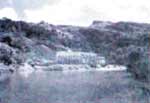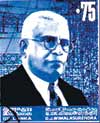He pioneered
hydro-power
Today marks the birth of the
Sri Lankan engineer who pioneered the concept
of hydro- electricity in Sri Lanka 132 years ago.
D. J. (Devapura Jayasena) Wimalasurendra, was
born on September 17, 1874 in Galle. As a student
at Ananda College, he showed great aptitude in
science and mathematics. At the beginning of the
20th century when professionally qualified engineers
was a rarity, he obtained Associate Membership
of the Institutes of Civil and Electrical Engineers
of England.
 |
| Laxapana - Sri Lanka's first power station. |
"I began as an overseer
and rose to the highest positions available to
a Ceylonese", is how he described himself,
addressing a debate in the State Council when,
after retirement, he represented Ratnapura in
the 1931 Council. He was a junior assistant engineer
in the Department of Public Works in 1901. When
the Department of Government Electrical Undertakings
was set up in 1927, he was appointed as the Chief
Engineer and Deputy Director.
After his appointment in 1901,
he travelled widely in the company of a Boer prisoner
of war from Transvaal, a minerologist, prospecting
for minerals. He carried out extensive investigations
into the possibilities of establishing water power
in the country. It is said that when the Boer
prisoner of war saw the Aberdeen and Laxapana
falls, he told Wimalasurendra, “why do you
look for gold under the earth when there is white
gold in those waterfalls.” Knowing that
it was hard for countries without plentiful electrical
power to prosper, he realised that Sri Lanka was
fortunate in having ample water resources to generate
electricity when the country lacked coal or oil
necessary for generating electric power.
As early as 1918, addressing
the Engineering Association of Ceylon, he stressed
on "the need for the exploitation and development
of the extensive sources of power available and
utilisation of them by rational generation and
distribution to meet the large demand for cheap
power in the country both for traction and industrial
purposes." He referred to the Aberdeen and
Laxapana waterfalls situated in the sources of
the Kelani ganga as a principal source of water
power. When he described the Mahaweli ganga as
“the greatest asset we possess in this respect,”
he was prophesying what was to come half a century
later.
 |
| D. J. Wimalasurendra |
Wimalasurendra emphasised the
need for the establishment of a network of “main
trunk electric roads passing through towns and
industrial centres of importance, thus bringing
to their very gates a supply of cheap power.”
As a member of the Executive
Committee of Communications & Works in the
State Council, he tried hard to get his proposals
implemented with little success. He was critical
of the British administration for not promoting
industries and stood against foreign control of
the economy.
His dreams began to be come
true only after the country gained Independence
in 1948 when his brain-child, the Laxapana hydro-electric
project was established. The scheme was based
on feasibility studies made many years earlier
by him for harnessing the Laxapana waterfalls.
By the time he died in 1953, he was happy that
his ideas were slowly but surely being implemented.
His services were recognised
with the release of a commemorative stamp on September
17,1975.
|
